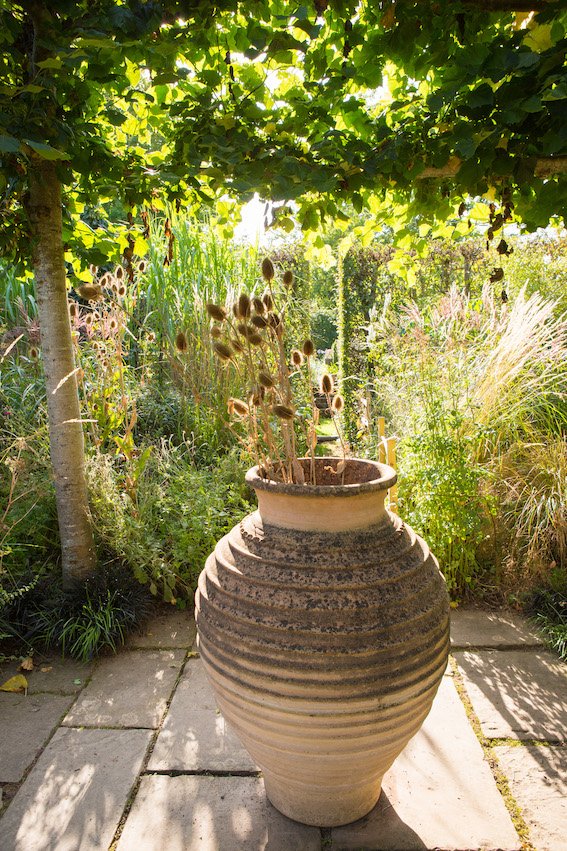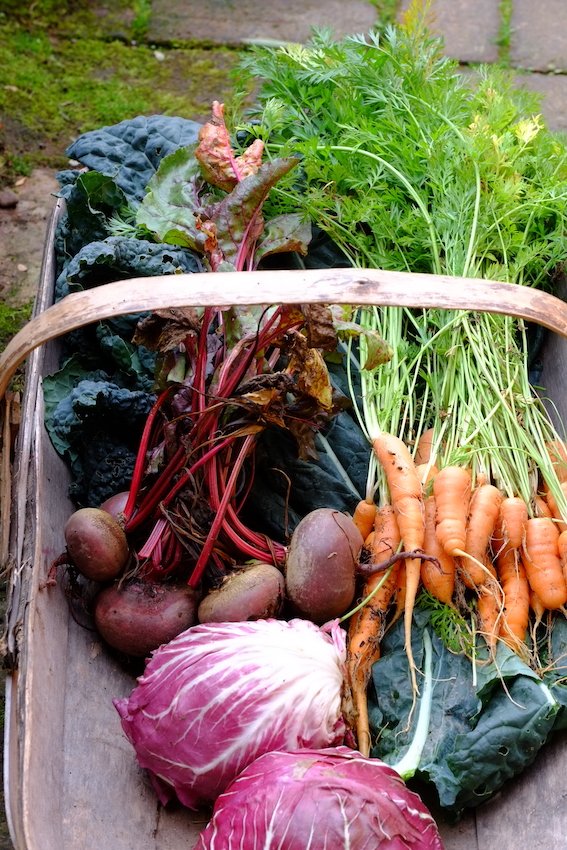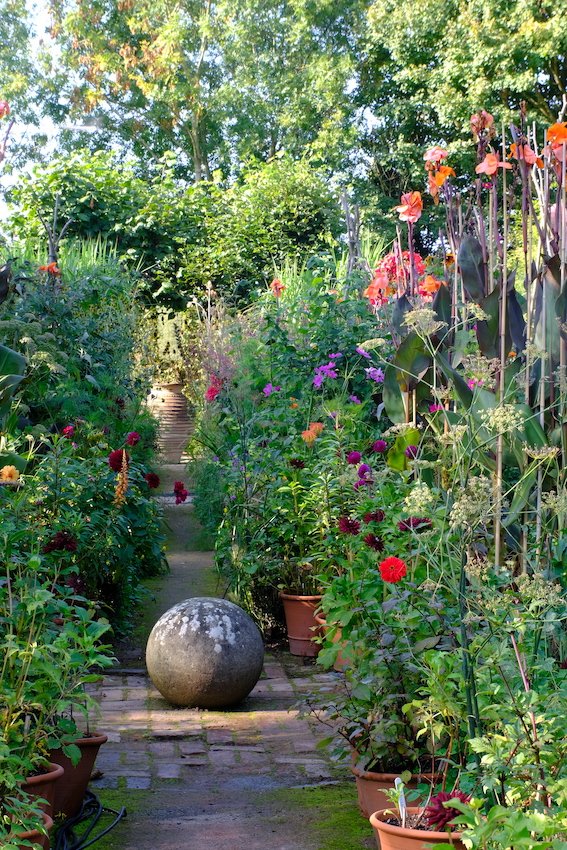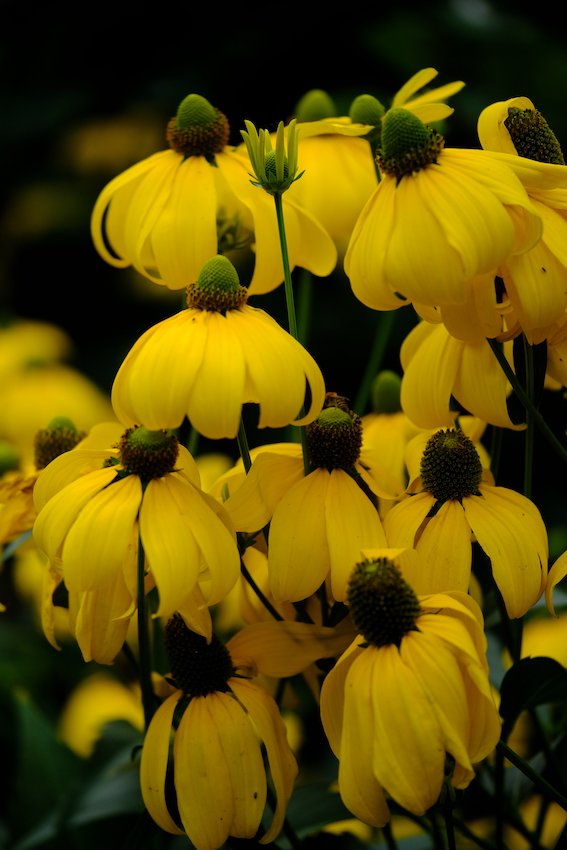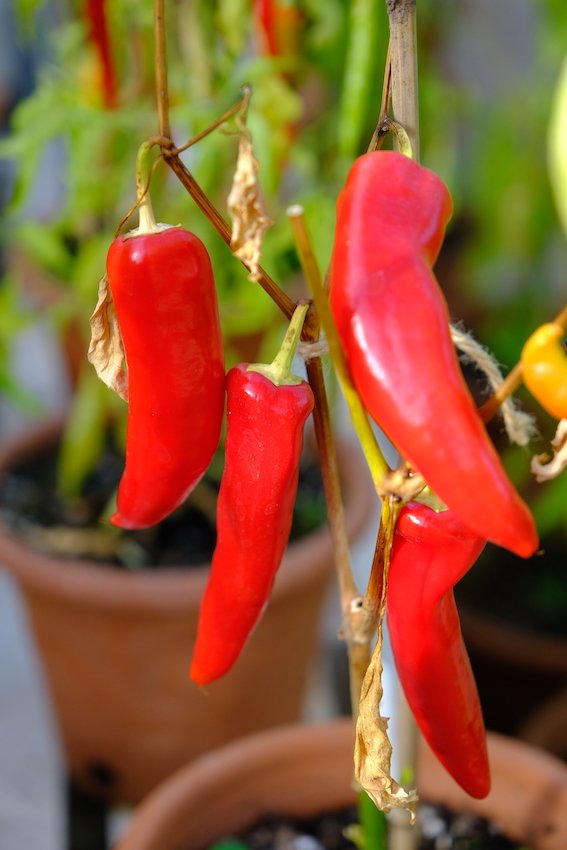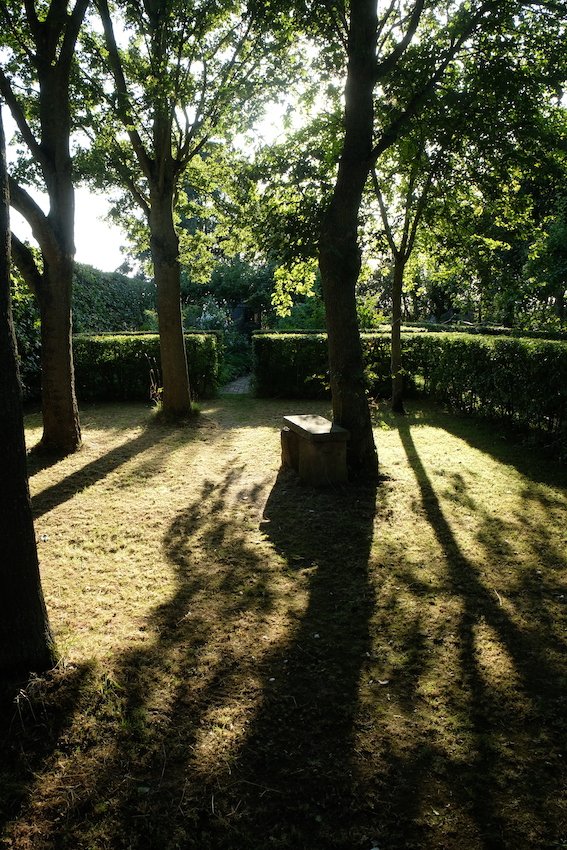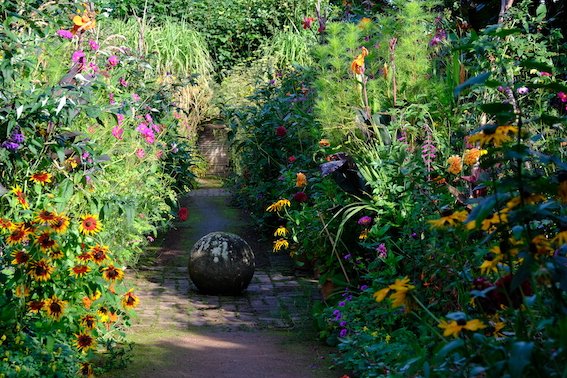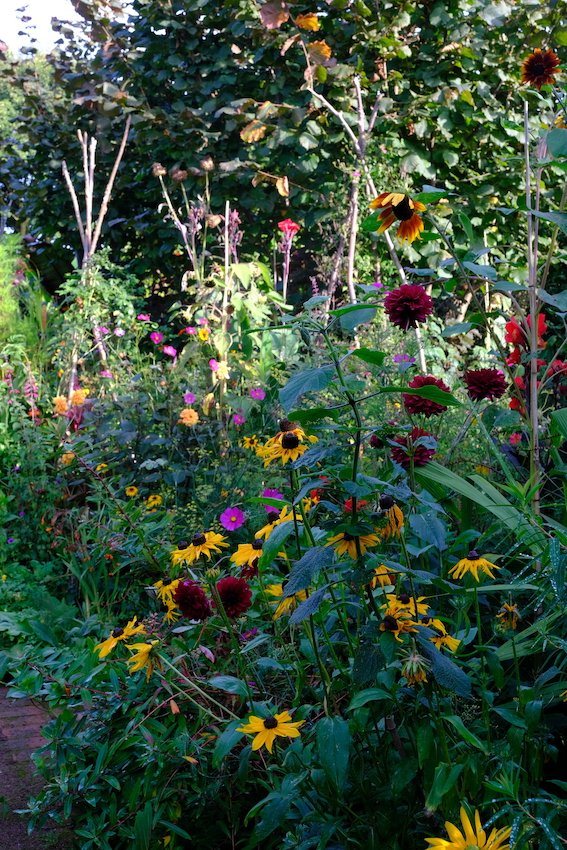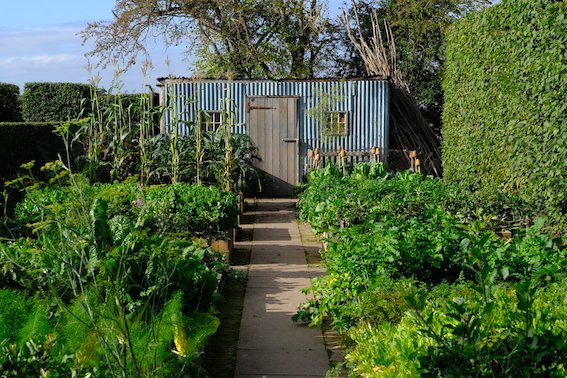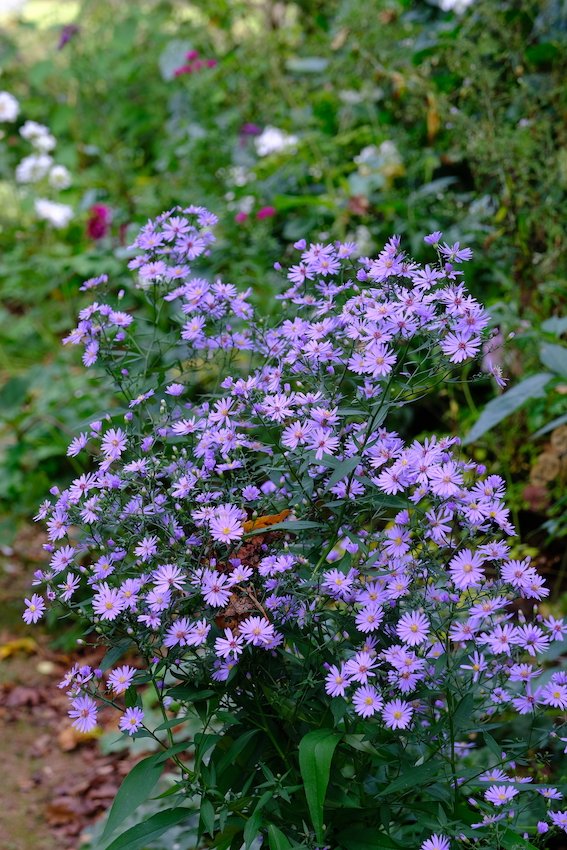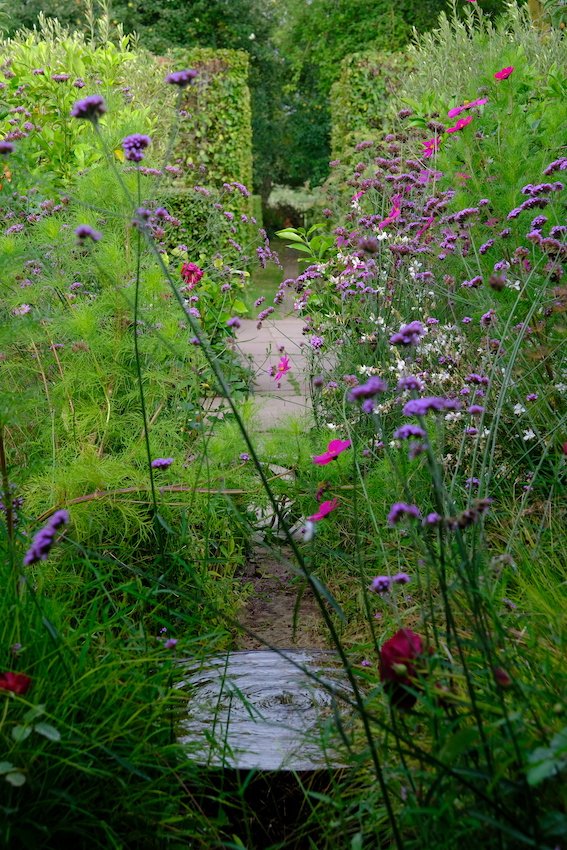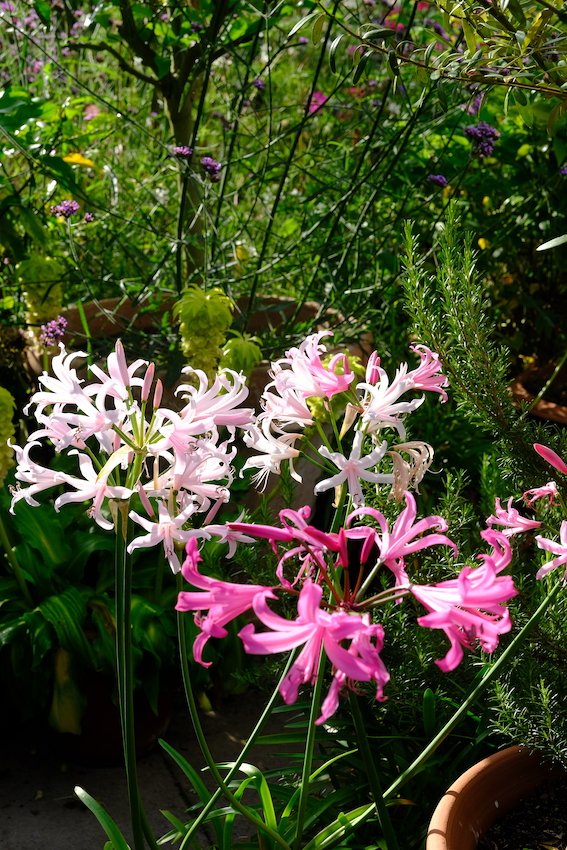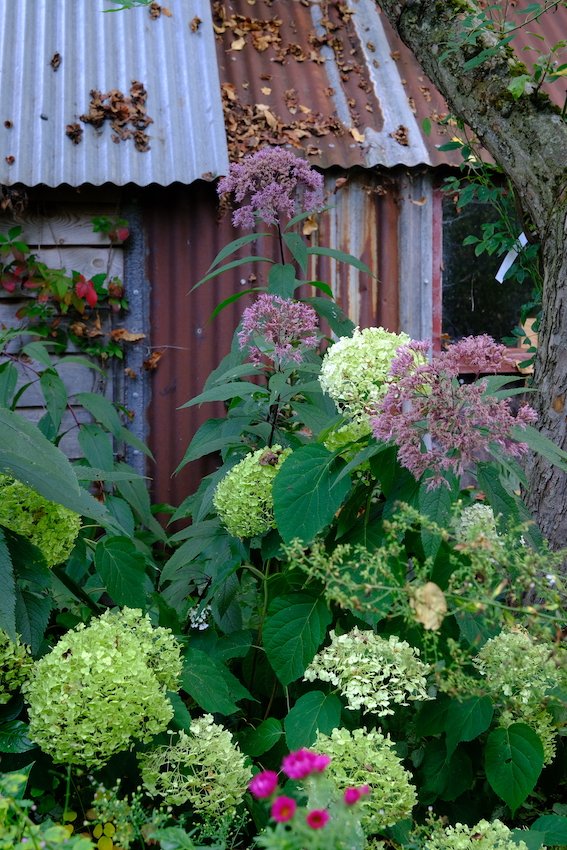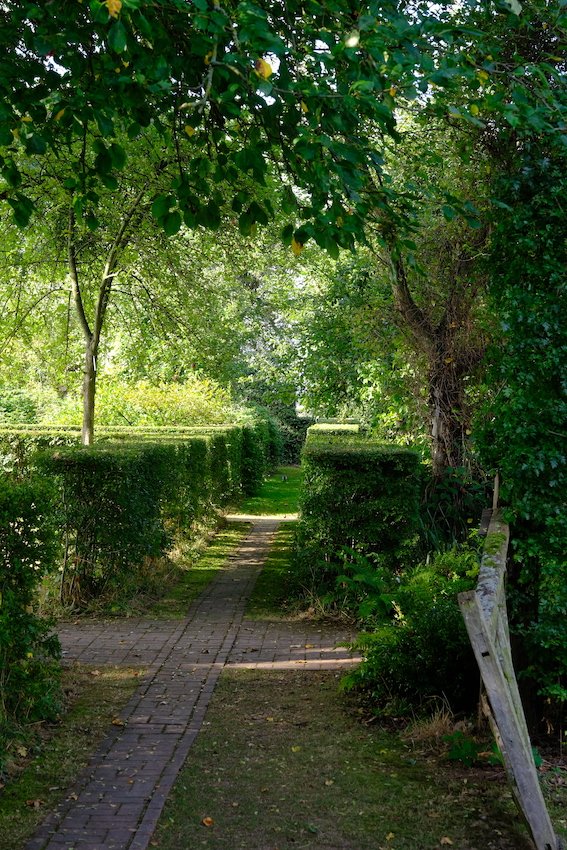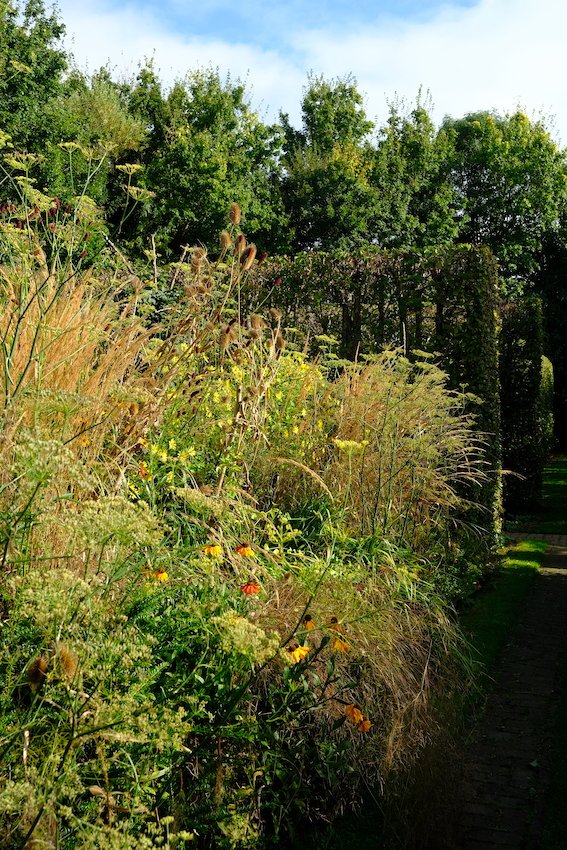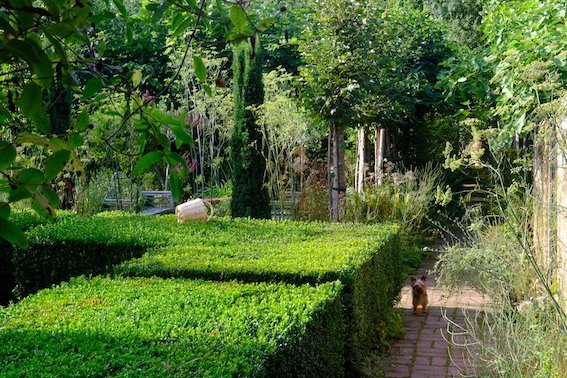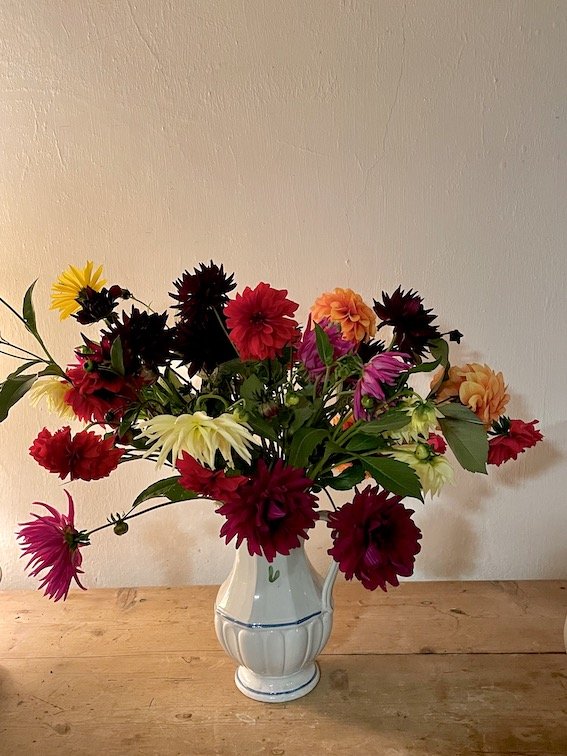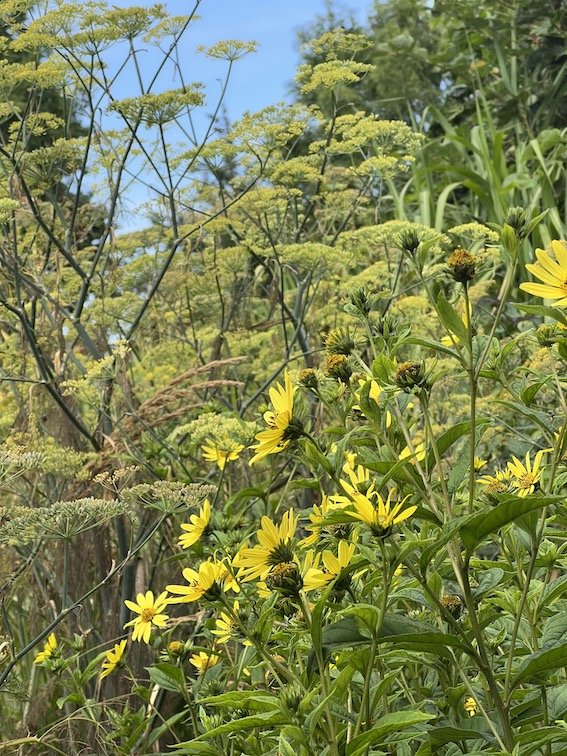September 2022
August remained dry at Longmeadow - and throughout much of the UK, although the extreme heat of July passed. In fact the weather was balmy and mild - but we longed for rain. We need an exceptionally wet autumn and/or winter to restore the water levels both in our garden soil and the reservoirs.
It has become increasingly apparent what survives, thrives or expires in drought. Often the results are surprising.
Prairie plants such as grasses, rudbeckias, echinacea, heleniums, Perovskia, Solidago, echinops and scabious of all kinds have thrived. However more tropical plants such as bananas and dahlias have suffered horribly. Interestingly Cannas - which do very well in warm, wet conditions, do not seem to have suffered.
Roses and clematis flowered well but went over sooner than normal. Mediterranean plants have barely missed a beat.
But the biggest thing we have noticed is how adding shade to the mix - from trees, hedges and even neighbouring plants - has dramatically made things worse for many plants that would otherwise have coped. Dry shade is truly the hardest of all horticultural conditions.
But this is an interesting challenge. The greatest lesson that climate change is forcing on us is that rather than changing the way that we do the same thing we need to rethink what we do literally from the ground up.
Over the coming year I will be adapting our planting to cope with the increasing chance of dry shade. Some of this can be done by removing the shade - pruning and thinning trees or even removing them and lowering the height of hedges - and some with a careful choice of plants.
Watch this space.
Peat
At the end of August the British government announced that peat will be banned as a component of any growing medium available to gardeners via a retail outlet from 2024.
Many of us believe that this piece of legislation should have been brought into force years ago but it is still commendable.
However professional growers will still be able to use peat both as part of their growing mediums for raising plants and in the compost that a plant is potted into for sale.
Extracting peat actively increases the release of greenhouse gases. Peat bogs only make 3% of the earth's surface and yet sequester up to 30% of all carbon locked into soil. The UK has already lost 80% of its natural peat bogs.
Extracting it from the ground is on a par with cutting down the rain forest. Each year Peat extraction in the UK contributes approximately 23 million tons of carbon into the atmosphere. That is roughly the same as 100 million average flying hours of commercial aircraft.
But unlike the rainforest, peat bogs do not rot but accumulate year on year. This means that they can store carbon for thousands of years without releasing it into the atmosphere. The are the ultimate carbon-soak.
This alone should deter all use of peat for any purpose, let alone gardening.
But there is more. A peat bog is a unique and specialised ecosystem that is not replicated anywhere else.
It takes a bulldozer minutes to destroy a peat bog that took hundreds, if not thousands, of years to form and will take as long again to recover. It is out and out eco-vandalism and no garden - not mine, not yours, nor any garden in the world is worth that.
Finally, if these were not two reasons enough, peat is never justifiable in horticultural terms because it is not irreplaceable. In my experience a variety of commercial composts made from bark, wood chip, coir, bracken and wool all work well and I think there is great potential for using the trillions of fallen leaves every autumn as compost.
To blame peat for less than perfect plant performance without making the effort to try any and every alternative and finding a way of making it work - as I and millions of other are already successfully doing - is just lazy and irresponsible.
The only way that we can deal with climate change is by taking a communal responsibility and acting responsibly for the future.
So all gardeners and growers should simply say no to peat today.
Marsha Arnold Garden Photography Workshop
The pictures of me on this website are all taken by Marsha Arnold, who is one of the country's leading garden photographers. I have worked with almost every garden photographer over the years and Marsha is one of the very best in the world and am fortunate to have worked closely with Marsha for over two decades. As well as countless journalistic assignments from my own garden, I have done three books with her - 'Gardening From Longmeadow', 'The Home Cookbook'(with my wife Sarah) and 'The Complete Gardener' and we are working on a fourth, to be published in Spring 2024.
Marsha runs garden photography workshops, set in great gardens, where you can develop your own skills through her immense experience and skills. If you go to her website marshaarnold.co.uk you will find all the details there. I cannot recommend them more highly.
Fungi
There are times when fungus can be seen as a plague to blight the garden, yet in just one gram of soil - about a teaspoonful - you would expect to find around 10,000 species of fungi. All are part of the indescribably complex synthesis that enables plants to grow healthily.
Most fungi exist below the ground as mycelium that have wide-spreading filaments that feed on decomposing matter. So a ‘Fairy Ring’ in your lawn marks the extent of the mycelium growing outwards underground like the spokes of a bicycle wheel. The reason that the grass is greener and longer at the outer limit of the circle is that the fungus has used all the nutrients in the soil within the circle whereas at the edge it excretes chemicals into the ground ahead to provide it with food and the grass temporarily responds by growing lusher.
Nearly 40% of the fungi in a healthy soil are vesicular arbuscular mycorrhizae, known as VAM, which penetrate the cells of a plants roots and create a kind of living link between the root and the minerals and water in the soil.
Most fungi thrive in warm, damp conditions and global warming means that our mild autumns and winters s are making fungal ‘problems’ more common. There is truly nothing you can do to stop this happening. But ensuring plenty of ventilation, healthy plants and good soil drainage can help a great deal as well as celebrating the essential and unsung work that fungi are doing to help our gardens grow right under our feet.
September Jobs
As always in the garden, many jobs roll over from month to month, be it weeding, deadheading or mowing the grass. Above all continue to deadhead daily, cutting back spent blooms to the next leaf - even if that means taking off quite a long length of stem.
Carry on collecting seeds as they ripen - and before they disperse - and once really dry, store them in a jar or paper envelope (NOT a plastic bag) in the fridge until you are ready to use them.
Take Cuttings
If you have not taken cuttings before - do not be daunted. They are easy, mostly successful and the gateway to producing scores of new plants for free. They also enable you to be very specific about what you want.
A plant grown from a cutting will always be exactly the same as its parent plant whereas one grown from seed will always be different.
Semi ripe cuttings are taken from current season’s wood that has started to harden off a little. The tip is soft and bendy but the base of the cutting will have wood that has started to become more rigid. This means that it will be slower to make new roots than a soft cutting but also be slower to die back and this allows for more flexibility and a much reduced sense of urgency about the whole proceedings.
Before you set put to take any cuttings have with you a plastic bag and a sharp knife and secateurs. The bag is for placing the cut material immediately into to reduce moisture loss. In principal it is best to take cuttings in the morning whilst the plant is full of moisture but in practise it is something best done as and when you are minded to do it.
Always choose healthy, strong, straight growth for cutting material. It should be free from any flowers or flower buds. Plants like rosemary will root successfully from side shoots that have been peeled from the main stem but where there is plenty of material I prefer to take shoots with the growing tip intact.
Once you have taken material from the plant and placed it in the polythene bag go and pot them up immediately. The quicker you can do this, the more likely you are to have success.
Strip off all lower leaves and side shoots so that only an inch or less of foliage remains. Cut the bare stem to size with a sharp knife just below a node (the point on a stem where leaves emerge) and bury it in a container of very gritty or sandy compost.
It is best to place the cuttings around the edge of a pot and you can always get at least 4 and often more in one container. Put this somewhere warm and bright but not on a south-facing windowsill as it may scorch.
Water it well and then keep it just moist but a daily spray with a mister will help stop the leaves drying out before new roots have time to form.
You will know that the roots have formed when you see fresh new growth. At that point the cuttings can be removed from the pot and potted on individually before planting out next spring.
Pruning Shrub Roses
I know that some gardeners are anxious about pruning roses but the many shrub varieties such as the gallicas, ‘english’ roses, albas or Hybrid Perpetuals are best simply trimmed with shears any time this month.
Do not worry about the position or angle of the cuts but clip away all long, straggly shoots as though you were trimming a hedge, leaved a compact, slightly domed bush that is about two thirds of its former size. In March, when you can see clearly without any foliage, you can inspect the shrub to remove any damaged or rubbing stems, but a simple shear in September is enough to keep it healthy and packed with flower next year.
Sow Grass Seed/Repair Lawns
This is an ideal time of year to either sow or turf new grass or to repair patches and worn areas on your lawn.
If it is just a worn area of thin grass, rake away all thatch and moss and remove all weeds and thinly scatter grass seed, watering well and keeping it damp. The seed should germinate and grow in days.Do not mow it for at least a month and if it looks unsightly going into winter clip the new growth with shears.
For a larger area clean the edges with a sharp spade, fork it over to remove any compaction and either scatter with seed or cut a piece of turf to fit, making sure that the edges are butted tightly against the existing grass.
Like grass seed, it is important that turf should not be walked on or mown until growing vigorously which will indicate that the roots have become established and are growing strongly. Depending on the weather, this may mean leaving it uncut until next spring.
Aerate Lawns
Even if your lawn has come through this summer unscathed, it is always a good idea to aerate it at this time of year.
You can use a fork by working the tines into the ground at 12 inch intervals or, for a larger lawn, hire a rolling hollow-tine or slitter. Ideally this is followed by working sand into the holes they create with a stiff brush.
Finally five the grass a though scratch with a wire rake, to remove all the thatch and moss and whilst it will look a little threadbare this autumn, next spring your lawn will be rejuvenated for this autumnal working over.
Apples
Start to pick over any apples at least once a week, checking to see if any are ripe by holding them in the palm of your hand and gently lifting and twisting to see if the stalk comes away easily. Do not force it as when it is ready they always pick very easily.
If apples are to be stored successfully - and if carefully placed in a cool, dark fairly moist place they will keep for months -they must be picked without any bruises or blemishes and any windfall, however seemingly perfect, will not keep and should be eaten fresh or cooked and then frozen.
If you have more windfalls than you can possible eat or process, consider hiring an apple press to make juice which can then be bottled and stored.
Ripening Tomatoes
Tomatoes ripen best when the temperature is between 26 & 30 degrees so this summer was too hot for many of them - especially if grown under glass and meant that many stayed green much longer than in a cooler summer. However by September the heat is running out and inevitably we are all left with green tomatoes that are never going to ripen. However if you pick them - either individually or on the bine, then put them in a drawer with a banana they will ripen and turn red.
Plant Bulbs In Pots
Spring bulbs are now on sale but the ground is often much too hard to plant them in grass at this stage of the year, so I always begin by planting some bulbs in pots.
I start with crocus, daffodils - especially smaller ones like ‘tete a tete’ - reticulate irises, muscari and scillas. These need not be special or different from those in your borders or grass but will flower a little earlier and can be positioned to maximum effect next spring.
Choose an attractive pot which need not be deep - a terracotta pan is ideal - and can be very small - a few crocus in a small pot can cheer the darkest February day. However, you will need to mix your compost with some grit to make sure the drainage is good and the bulbs do not become waterlogged over winter. Place the planted pots in a sheltered position ready to move into the sun when new growth appears.
Pruning Summer-Fruiting Raspberries
The old brown canes of Summer-fruiting raspberries can now all be cut down to the ground, leaving the fresh new green canes standing. These new canes will carry next summer’s crop.
It is a good idea to reduce these to the half dozen strongest shoots, taking out all smaller or awkwardly positioned growth. The remaining canes will need holding securely for the next year and therefore summer raspberries are best grown against a permanent system of support.
I tie the canes with twine to parallel wires fixed strongly between robust posts, weaving round them and fanning them out them evenly as I work along the wire at each level. It is important that it is really secure as winter winds can catch and damage them.
Plant Garlic
There are two types of garlic, hardneck and softneck. The type you mostly buy is softneck which has a plaitable stem, stores well (which is why shops stock it) and is often excellent. But the best, tastiest garlic is hardneck which has a stiff, upright stalk and because it is much harder to buy it makes sense to grow it yourself.
Hardneck varieties such as ‘Red Duke’, ‘Rocambole’, or ‘Early Purple Wight’ are slower to grow so should be planted in September if possible whilst softneck varieties can wait till October or even November.
Like all garlic of any type, plant plump individual cloves (the bigger the clove the bigger the bulb it will generate) about 6 inches apart , pointed end up and buried a good inch below the surface in good but well-drained soil. Shoots will appear in about 6-8 weeks.
Sow Spinach
Spinach is a very hardy crop that grows best in mild weather and will quickly germinate and establish if sown in early September to provide young leaves in autumn and an over-wintering crop to be harvested right through to late Spring next year - by which time a spring-sown crop will have established.
Rake the ground to a level tilth and draw rills about an inch deep and 9-12 inches apart. (I use a scaffolding board, running a drill down either edge, to measure the width, ensure straightness and to stand on) Sprinkle the seed thinly and evenly, trying to space them an inch or so apart. Cover them over and water. They should germinate in 7-10 days.





